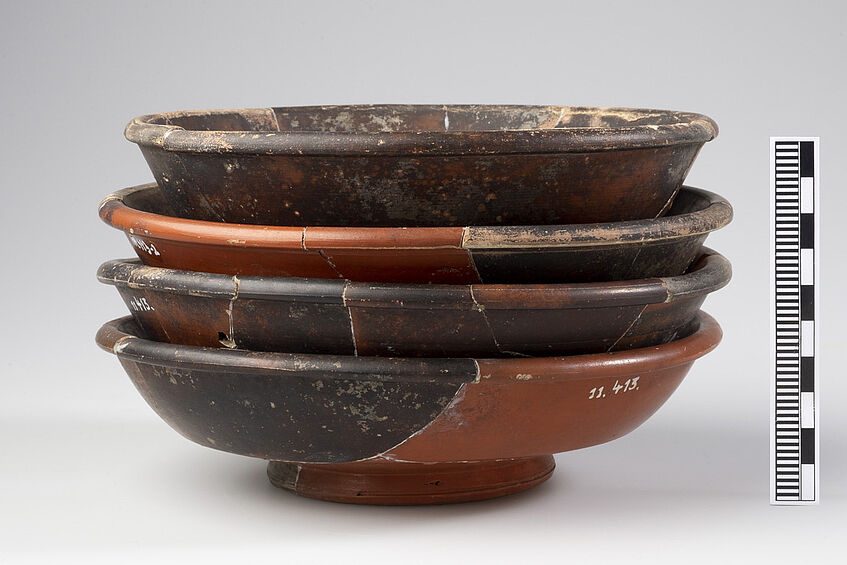Dissertation project
Working title: “Pre-consumption deposits: An examination regarding the production of Terra Sigillata and its trading network in the 2nd c. AD”
Contact: Marina Palmieri, BA MA
Supervisors: Univ.-Prof. Günther Schörner, Univ.-Ass. Dr. Julia Kopf


The term pre-consumption deposit refers to a type of assemblage that was buried between the stages of production and utilisation by consumers. With the help of such ceramic deposits, the various processes from production to storage at the trading destination can be traced. However, for various reasons that are often unknown today, the material never reached the consumers. Compared to conventional household waste, they display certain characteristics. What is striking about this type of assemblage is the limited repertoire of forms, whereby a few forms are present in very large numbers. Another characteristic is the high proportion of complete vessels. These may be heavily fragmented, but many matching pieces can be detected and thus many complete vessels can be reassembled. Pre-consumption deposits also often have many stamps from only a few potters. In addition, traces of use and ownership markings in the form of graffiti, which are typical of common ceramic settlement finds, i.e. regularly used pottery, are largely absent. Due to these characteristics, pre-consumption deposits indicate assemblages that were never used in their intended function after their production.
The significance of these assemblages and their untapped potential for the study of pottery will be investigated in more detail as part of the dissertation project. The focus of the work is on pre-consumption deposits, which consist mainly of terra sigillata (red-slipped fine pottery) and are dated to the middle of the 2nd century AD. The Central Gaulish terra sigillata is of great importance during this period. It was mainly produced in the production centres of Lezoux and Martres-de-Veyre, which reached the peak of their importance in the 2nd century after they had replaced the monopoly of South Gaulish production. The vessels were largely exported to the northern regions of the Roman Empire, such as Britannia, Raetia and Germania Superior, and were also distributed in the Gallic provinces themselves. From the middle of the 2nd century, terra sigillata from Rheinzabern also began to gain in importance, replacing Central Gaulish production in the 3rd century. Pre-consumption deposits not only bear witness to the export of terra sigillata to various locations but also provide us with a significant picture of the trade network of the 2nd century in the north-western provinces of the Roman Empire.
The starting point of the dissertation project is a pre-consumption deposit from Bregenz, also known as the Sammelfund 1911. This find complex was excavated more than 100 years ago, but never examined and published. The material from this find, which consists of South and Central Gaulish sigillata from the 2nd century, is being studied and analysed as part of the FWF project "Meaningful sherds: sigillata from pre-consumption deposits" (P34600-G) under the direction of Dr Julia Kopf.
The investigation and comparison of the various sites and pre-consumption deposits reveal differences and similarities that allow further conclusions to be drawn about the production of the terra sigillata itself, its trade routes and supply mechanisms.
Bibliography (selection)
- G.B. Dannell – A.W. Mees, Getting samian ware to Britain: routes and transport possibilities, JRomPotSt 16, 2015, 77–92.
- M. Fulford, Shops, Stalls, Stores: Pre-consumption deposits and centrally organised distribution in Antonine Britain, Britannia 45, 2014, 279–284.
- A. Hild, Archäologische Forschungen in Bregenz, ÖJh 26, 1930, Beibl. 115–176.
- M. Rhodes, Roman Pottery lost en route from the kiln site to the user – A Gazetteer, JRomPotSt 2, 1989, 44–58.
- M. Weber, A Reassessment of Pre-Consumption Deposits and Samian Export in the Antonine Period, in: M. Fulford – E. Durham (Hrsg.), Seeing Red. New economic and social perspectives on Terra Sigillata. BICS Suppl. 102 (London 2013) 188–209.
Contact: Marina Palmieri, BA MA
E-Mail: marina.palmieri@univie.ac.at
